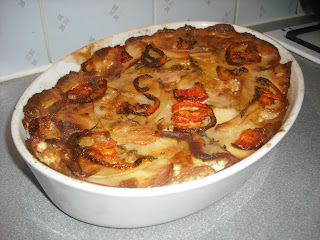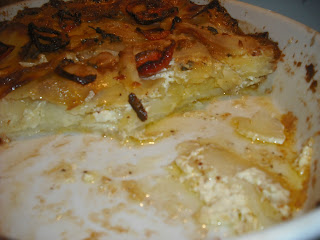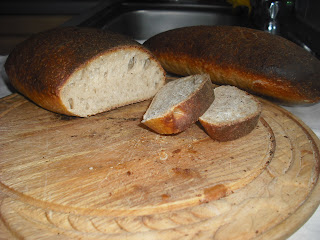Since being married I have had the good fortune (or not) of moving house quite a few times over the years which has also entailed living in three countries. One thing has remained constant, though, and that is my love for cookbooks - I've never stopped buying them wherever I was living. Consequently, when buying a book I always wrote the date and where I was living at the time inside the front cover. Thank goodness I've done this because when I open up a cookbook I'm immediately transported back to that particular time, the memories of that house and stage of my life.
I bought Clarissa's Comfort Food when I lived in an English house in the Berkshire Downs in 2008, the year this book was published. In the winter of living in that house the boiler broke down and for ten days we had no hot water and no heating. TEN whole days. Up until then, I had never in my life thought about heating and hot water. Needless to say, bathing in a hip bath made of about 15 kettles of boiling water, getting out if it to dry and dress as fast as possible because the bathroom was like the Arctic, for over a week, made me realise very quickly how I had taken these luxuries for granted for so long.
Clarissa's Comfort Food seemed to be apt for the time I lived in that house. It delivered exactly what it promised, particularly during that bloody cold winter. Each recipe I made was comforting, reminiscent of childhood dishes made by grandmothers, old-fashioned and timeless. This recipe for potatoes (which Clarissa says are great with roasted meat), is cooked slowly with cream and is the best of its type I've ever made. Truly.
The dish is simplicity itself and, like the entire book, reflects Clarissa's no fuss approach. Her writing is stylish, simple, witty and intelligent. She writes in the familiar way she speaks, interspersing fact with tale and anecdote, always entertaining and with just the right dose of sense and perspective. She's had a very interesting life and despite her background, never comes across as being superior or a know-all. She knows all when it comes to food, however, and I imagine she is not impressed by any food trends or fashions in dining. She brings food to the table precisely how it should be: simple, pared down and utterly delicious.
For this recipe, I used King Edward potatoes, double cream, tomatoes, thyme, butter, nutmeg and salt.
The potatoes were sliced thinly and washed well to remove the starch. They were layered, sprinkled with nutmeg, salt and pepper over each layer until the casserole dish was half filled, then half the cream was added.
Repeat layering of potatoes and seasoning then top with tomatoes and a few sprigs of thyme, finishing off by pouring the rest of the cream on top.
It is left to cook long and slow in a low oven and when cooked ... well, look at this:
My photos do not do justice to the utterly buttery creamy and delicious cheesy-like flavours from this slow cooked gratin. The double cream became soft and cheese-like in texture.
Verdict: Sublime. Truly. You can just see some of the white cream which has melded with the butter to produce a gorgeously soft cheese consistency and flavour. This was simple and so delicious. Even better than potatoes Dauphinois.
Who can make this? Anybody, as long as a grown-up slices the potatoes. Get the teenagers involved in helping with the Sunday roast.
pommes clarise
Clarissa's Comfort Food, Clarissa Dickson Wright, Kyle Cathie Limited, London, 2008
Saturday, 23 February 2013
Sunday, 17 February 2013
cake
For some reason I have never been a big fan of coffee cake, until now. This is because I had never eaten a good one. The revelation came after eating this simple coffee cake from Lorraine Pascale, of whom I am now a devoted fan. The most important criteria for a cookbook is that the recipes work. After you buy a cookbook and attempt several recipes, finding them easy to read, straightforward to make, turning out well and most of all, tasting delicious, then you know you have discoverd a reliable author. And you stick with them, because the success of their recipes is your success.
But back to cake.
After preparing two sandwich tins with butter and paper, 3 tabs of coffee in one tablespoon of hot water are mixed first.
Then flour, sugar and baking powder are mixed to combine, adding the butter, eggs, vanilla extract, prepared coffee and chopped walnuts. All this is beaten well then divided into the prepared tins and put in the oven for about 25 minutes.
Just before the cakes are ready a coffee syrup is made with instant coffee, sugar and hot water. Once the cakes come out they are brushed whilst hot with the coffee syrup. After five minutes the sponges are taken out of the tins to cool completely.
| coffee syrup soaking into hot sponges |
All that is left to do is assembly. One sponge, one layer of buttercream, the other sponge on top and then the rest of the buttercream is spread liberally on top. Walnuts are added for the traditional decoration.
Then nothing left to do but dive in.
| ( need a cake fork ... ) |
For afternoon tea, this cake is delectable but what better accompaniment could you have with your morning coffee too?
Verdict: Addictive cake for coffee lovers. A true coffee flavour rather than the usual coffee-ish flavour that most coffee cakes produce. It is light in texture, the buttercream and walnuts equally balancing creamy and crunchy textures, the overall mouthful being one harmonious coffee/sweet delight. Did I like this cake? What do you think?
coffee, vanilla & walnut cake
Fast, Fresh and Easy Food, Lorraine Pascale, HarperCollinsPublishers, London 2012
Sunday, 10 February 2013
tart au pamplemousse et poivre meringues
First it was the 'pepper meringue' in the heading of this recipe that made me stop. Then it was the image of what looked like sponge, oozing curd topped with a thick meringue. But that weird addition of pepper in the meringue ... Quoi?! But what finally got me in was that wonderful French word for grapefruit - pamplemousse. There always comes a point when I am deliberating about what to bake or eat where I suddenly know what I want. C'est tout! What does grapefruit and pepper in meringue taste like ... ?
Not unlike the passion fruit meringue tarts I made a couple of weeks ago, this recipe has exactly the same elements, but with a biscuit base which looks sponge-like and a curd which should be soft and oozy but not set as a mousse in my pasionfruit tart recipe. I happened to have bought a bag of pamplemousse at le supermarche yesterday, and I had all other ingredients already. Excellent.
First the grapefruit curd. Un pamplemousse was zested (is that a word?) and juiced, and was heated and whisked in a saucepan with sugar, salt and an eggs over a gentle heat. Then sifted corn flour was added and whisked in. At the bubbling stage, the saucepan was taken off the heat and then cubes of butter were mixed in. Finally the curd was poured into a bowl, plastic wrap covered and refrigerated overnight.
I preheated the oven to 180 deg C. The biscuit base was made creaming butter and sugar with salt and lemon zest until it was fluffy and pale. Egg yolks were added with more beating.
Sifted flour and baking powder were added to the creamed mixture until a smooth paste formed. I made one large instead of 8 small tarts, so the biscuit base was spread in a spring form pan, then baked for approx 20 minutes.
To make my favourite, Italian meringue, I poured caster sugar into a saucepan with water and placed it on a high heat and it was brought to the boil - at 118 deg C (how I do this without a thermometer, I don't know but I seem to guess correctly).
sugar and water to make sugar syrup
Then meringue was made whisking the egg whites until soft and then when the syrup had cooled I poured it carefully down the side of the bowl before it could hit the beaters. It was now I added the pepper. Then about 8 minutes whisking produced gorgeously fluffy meringue which I could have eaten then and there, but refrained.
There was just the assembly (sans image which I forgot) to complete once the biscuit base had cooled. The pamplemousse curd was spread over it, and then the meringue which was so gorgeous and fluffy it was almost like marshmallow. Under the grill it went for not even two minutes, and here's the result.
Once it had cooled ...
| (need a proper cake fork) |
The Verdict: Very very good and surprising. Overall, sweetness meets bitter, with a touch of sour and then marshmallow sweetness with pepper! I especially like the base which is a traditional Breton biscuit base, which didn't need chilling or rolling. The addition of the lemon zest in the dough married well with the bitter grapefruit curd which was creamy sweet at the same time.
There are so many more recipes yet to be tried from this delightful book.
The Little Paris Kitchen, Classic French recipes with a fresh and simple approach Rachel Khoo, Michael Joseph, London, 2012
Sunday, 3 February 2013
Finally, sourdough baking
This morning, after 12 hours' retarding of the sourdough loaves, they were ready for the final proving (see yesterday's post). In order to create a warm, humid environment for their final proving I turned on the heating, the oven and put a pan of water on the stove to simmer away, creating the necessary steam. Here's what the loaves looked like before final proving:
 |
| Ready for final prove after 'retarding' in cold environment overnight |
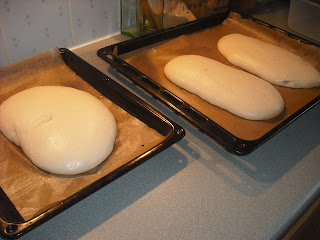 |
| after final prove - ready for the oven |
After 20 mins I turned the trays around and swapped shelves so that all loaves baked evenly. At this stage I could see that they were baking more in some spots than others, so this step was vital. Finally, after another 10 mins of baking, I decided they smelled ready and looked almost burnt and should come out. Indeed, one of them was a bit overdone, but when I cut into it, it was fine.
Here's the final result, and I must say, I was thrilled. It was cooked, the bottom was not soft and the best part - look at all those lovely holes!!!
 |
| the taste test - only butter needed |
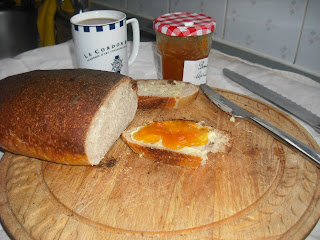 |
| the final taste test - with apricot jam |
I am so inspired to keep my sourdough starter going for a long time and make sourdough on a weekly basis. After all, a lot of effort went into making the starter and now I have one established I intend to use it. (Sourdough starter can even be frozen, so I put 100g in the freezer for the time I might need it).
The Bourke Street Bakery's by-line says it is the 'ultimate baking companion', and after really studying it I can vouch for that claim. The book starts off with 20 pages on 'before you begin', all about ingredients and equipment. Then there are nealy 20 pages on bread, different stages and techniques, all very detailed. The bread section alone has close to 40 pages on sourdough and derivative breads and then a further two chapters on yeasted and olive oil breads (which I am going to try). Then a large section on pastries, and a final section on cakes, biscuits and desserts.
Highly recommended.
Saturday, 2 February 2013
Dough Making Day - end 3rd week of feeding starter
Today is Dough Making Day.
This is the day my starter* becomes dough.*(A starter is the key component in baking sourdough bread. It is used in place of yeast. Through natural fermentation and feeding, the starter grows. Each day more flour and water are added and left for 24 hours. On day five the dough weighs 800g, then 700g is discarded so that the five day cycle can be repeated for three weeks to produce a strong starter.)
On the day of dough making the starter needs three extra feeds before making the dough. It will need to be proved overnight for baking in time for lunch tomorrow. Yes, still more patience involved!
I began these extra feeds yesterday. First feed of 50g each of flour + water was at 1pm. Second feed of 100g each of flour + water was at 9pm. Third feed was at 6am today. By lunch time
This is what it looked like at 1pm today.
Now here is the process to make sourdough bread. 400g of my starter was placed in the bowl with a dough hook attachment. To this plain flour and water were added. This was mixed for about 7 minutes until the rough dough was formed. The bowl was covered and rested for 20 mins.
Then sea salt was added and the dough mixed until it became elastic. After second mix, a little dough ball was stretched out to see its elasticity. When it looks like this and doesn't break, then it is ready for another hour's rest in a lightly greased bowl and covered with plastic to bulk prove for an hour.
Bulk proving is where the dough has come out of the mixture and sits in an oiled container.
| 'elastic' stage reached means it's ready for bulk proving |
After an hour, the dough is ready to be knocked back. This is where the dough is folded over itself a few times to help redistribute dough temperature, activate the gluten strands after resting and let built-up gas to be released. First I flattened out the dough with my hands, then folded one third into the centre,
and second fold over the first.
Then the dough is turned 90 degrees and the same folding is repeated.
After the last fold, the dough is put back into the oiled bowl and left to bulk prove for another hour.
At 5pm the dough is finally ready to be divided into 3 x 500g portions. Each portion was firstly shaped into a ball and left to rest for 20 minutes.
Finally each ball was shaped into a batard, which is a shorter, wider loaf than a baguette. The technique for shaping was similar to above but by repeatedly folding the dough in on itself, creating tension and a smooth form. The seam is closed and placed face down.
After shaping they were rested for the retarding phase for 8 - 12 hours. This is a long slow fermentation allowing the bread to develop its characteristic sourness. I put them out in my conservatory until tomorrow morning, as it as cold as the fridge.
Then tomorrow, I'll see if it all turns out!
Subscribe to:
Posts (Atom)


